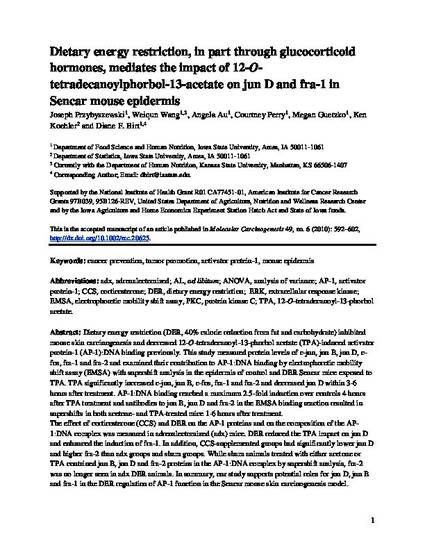
Dietary energy restriction (DER, 40% calorie reduction from fat and carbohydrate) inhibited mouse skin carcinogenesis and decreased 12-O-tetradecanoyl-13-phorbol acetate (TPA)-induced activator protein-1 (AP-1):DNA binding previously. This study measured protein levels of c-jun, jun B, jun D, c-fos, fra-1, and fra-2 and examined their contribution to AP-1:DNA binding by electrophoretic mobility shift assay (EMSA) with supershift analysis in the epidermis of control and DER Sencar mice exposed to TPA. TPA significantly increased c-jun, jun B, c-fos, fra-1, and fra-2 and decreased jun D within 3–6 h after treatment. AP-1:DNA binding reached a maximum 2.5-fold induction over controls 4 h after TPA treatment and antibodies to jun B, jun D, and fra-2 in the EMSA binding reaction resulted in supershifts in both acetone- and TPA-treated mice 1–6 h after treatment. The effect of corticosterone (CCS) and DER on the AP-1 proteins and on the composition of the AP-1:DNA complex was measured in adrenalectomized (adx) mice. DER reduced the TPA impact on jun D and enhanced the induction of fra-1. In addition, CCS-supplemented groups had significantly lower jun D and higher fra-2 than adx groups and sham groups. While sham animals treated with either acetone or TPA contained jun B, jun D, and fra-2 proteins in the AP-1:DNA complex by supershift analysis, fra-2 was no longer seen in adx DER animals. In summary, our study supports potential roles for jun D, jun B, and fra-1 in the DER regulation of AP-1 function in the Sencar mouse skin carcinogenesis model.
Available at: http://works.bepress.com/diane_birt/19/

This is the accepted manuscript of an article published in Molecular Carcinogenesis 49, no. 6 (2010): 592–602, http://dx.doi.org/10.1002/mc.20625.